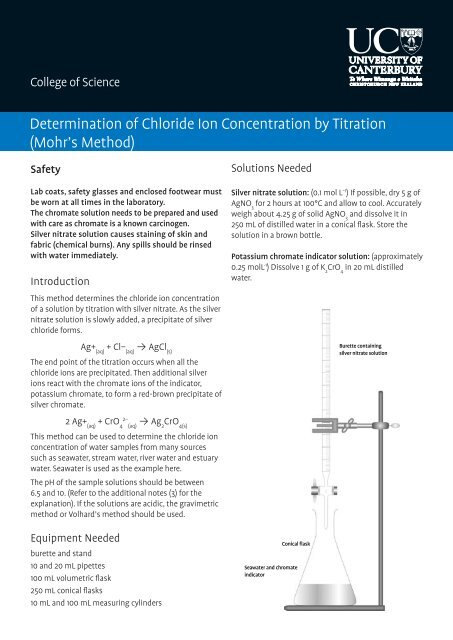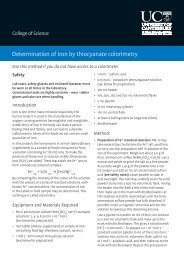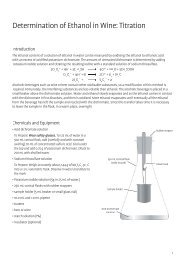Determination of Chloride Ion Concentration by ... - Science Outreach
Determination of Chloride Ion Concentration by ... - Science Outreach
Determination of Chloride Ion Concentration by ... - Science Outreach
You also want an ePaper? Increase the reach of your titles
YUMPU automatically turns print PDFs into web optimized ePapers that Google loves.
College <strong>of</strong> <strong>Science</strong><br />
<strong>Determination</strong> <strong>of</strong> <strong>Chloride</strong> <strong>Ion</strong> <strong>Concentration</strong> <strong>by</strong> Titration<br />
(Mohr’s Method)<br />
Safety<br />
Lab coats, safety glasses and enclosed footwear must<br />
be worn at all times in the laboratory.<br />
The chromate solution needs to be prepared and used<br />
with care as chromate is a known carcinogen.<br />
Silver nitrate solution causes staining <strong>of</strong> skin and<br />
fabric (chemical burns). Any spills should be rinsed<br />
with water immediately.<br />
Introduction<br />
This method determines the chloride ion concentration<br />
<strong>of</strong> a solution <strong>by</strong> titration with silver nitrate. As the silver<br />
Introduction<br />
nitrate solution is slowly added, a precipitate <strong>of</strong> silver<br />
chloride forms.<br />
Ag+ + Cl– → AgCl<br />
chloride (aq) forms. (aq) (s)<br />
The end point <strong>of</strong> the titration occurs when all the<br />
Ag<br />
chloride ions are precipitated. Then additional silver<br />
ions react with the chromate ions <strong>of</strong> the indicator,<br />
potassium chromate, to form a red-brown precipitate <strong>of</strong><br />
silver chromate.<br />
+ + Cl–<br />
(aq) (aq) → AgCl (s)<br />
The end point <strong>of</strong> the titration occurs when all the<br />
ions react with the chromate ions <strong>of</strong> the indicator,<br />
2–<br />
2 Ag+ + CrO (aq) 4 (aq) → Ag2CrO4(s) 2 Ag<br />
This method can be used to determine the chloride ion<br />
concentration <strong>of</strong> water samples from many sources<br />
such as seawater, stream water, river water and estuary<br />
water. Seawater is used as the example here.<br />
+<br />
(aq) + CrO 2–<br />
4 (aq) → Ag2CrO4(s) water. Seawater is used as the example here.<br />
The pH <strong>of</strong> the sample solutions should be between<br />
6.5 and 10. (Refer to the additional notes (3) for the<br />
6.5 and 10. (Refer to the additional notes (3) for the<br />
explanation). If method the solutions or Volhard’s are method acidic, should the gravimetric<br />
be used.<br />
method or Volhard’s method should be used.<br />
Equipment Needed<br />
Equipment Needed<br />
burette and stand<br />
10 and 20 mL pipettes 100 mL volumetric flask<br />
100 mL volumetric 250 mL flask conical flasks<br />
250 mL conical flasks<br />
10 mL and 100 mL measuring cylinders<br />
Solutions Needed<br />
Solutions Needed<br />
Silver nitrate solution: (0.1 mol L −1 ) If possible, dry 5 g <strong>of</strong><br />
AgNO 3 for 2 hours at 100°C and allow to cool. Accurately<br />
weigh about 4.25 g <strong>of</strong> solid AgNO 3 and dissolve it in<br />
250 mL <strong>of</strong> distilled water in a conical flask. Store the<br />
solution in a brown bottle.<br />
<strong>Determination</strong> <strong>of</strong> <strong>Chloride</strong> <strong>Ion</strong><br />
<strong>Concentration</strong> <strong>by</strong> Titration (Mohr’s Method)<br />
This method determines the chloride ion concentration<br />
<strong>of</strong> a solution <strong>by</strong> titration with silver nitrate. As the silver<br />
nitrate solution is slowly added, a precipitate <strong>of</strong> silver<br />
chloride ions are precipitated. Then additional chloride<br />
potassium chromate, to form a red-brown precipitate <strong>of</strong><br />
silver chromate.<br />
This method can be used to determine the chloride ion<br />
concentration <strong>of</strong> water samples from many sources<br />
such as seawater, stream water, river water and estuary<br />
The pH <strong>of</strong> the sample solutions should be between<br />
explanation). If the solutions are acidic, the gravimetric<br />
burette and stand<br />
10 and 20 mL pipettes<br />
10 mL and 100 mL measuring cylinders<br />
Silver nitrate solution:(0.1 mol L −1 ) If possible, dry 5 g <strong>of</strong><br />
AgNO 3 for 2 hours at 100°C and allow to cool. Accurately<br />
Potassium chromate indicator solution: (approximately<br />
0.25 molL-1 ) Dissolve 1 g <strong>of</strong> K CrO in 20 mL distilled<br />
2 4<br />
water.<br />
Conical flask<br />
Seawater and chromate<br />
indicator<br />
Burette containing<br />
silver nitrate solution
Sample Preparation<br />
If the seawater contains traces <strong>of</strong> solid matter such as<br />
sand or seaweed, it must be filtered before use.<br />
Titration<br />
1. Dilute seawater <strong>by</strong> pipetting a 20 mL sample into a<br />
100 mL volumetric flask and making it up to the mark<br />
with distilled water.<br />
2. Pipette a 10 mL aliquot <strong>of</strong> diluted seawater into a<br />
conical flask and add about 50 mL distilled water and<br />
1 mL <strong>of</strong> chromate indicator.<br />
3. Titrate the sample with 0.1 mol L−1 as sand or seaweed, it must be filtered before use.<br />
Otherwise they will end up being weighed along with<br />
the silver chloride precipitate.<br />
1. Dilute seawater <strong>by</strong> pipetting a 20 mL sample into<br />
a 100 mL volumetric flask and making it up to the mark<br />
with distilled water.<br />
2. Pipette a 10 mL aliquot <strong>of</strong> diluted seawater into a<br />
conical flask and add about 50 mL distilled water and 1<br />
mL <strong>of</strong> chromate indicator.<br />
3. Titrate the sample with 0.1 mol L<br />
silver nitrate<br />
solution. Although the silver chloride that forms is<br />
a white precipitate, the chromate indicator initially<br />
gives the cloudy solution a faint lemon-yellow colour<br />
(figure 1).<br />
−1 Sample Preparation<br />
If the seawater contains traces <strong>of</strong> solid matter such<br />
as sand or seaweed, it must be filtered before use.<br />
Otherwise they will end up being weighed along with<br />
the silver chloride precipitate.<br />
Titration<br />
1. Dilute seawater <strong>by</strong> pipetting a 20 mL sample into<br />
a 100 mL volumetric flask and making it up to the mark<br />
with distilled water.<br />
2. Pipette a 10 mL aliquot <strong>of</strong> diluted seawater into a<br />
conical flask and add about 50 mL distilled silver water nitrate and 1<br />
solution. mL <strong>of</strong> chromate Although indicator. the silver chloride that forms is a<br />
white precipitate, the chromate indicator initially gives<br />
3. Titrate the sample with 0.1 mol L<br />
the cloudy solution a faint lemon-yellow colour (figure<br />
1). The endpoint <strong>of</strong> the titration is identified as the first<br />
appearance <strong>of</strong> a red-brown colour <strong>of</strong> silver chromate<br />
(figure 2).<br />
4. Repeat the titration with further aliquots <strong>of</strong> diluted<br />
seawater until concordant results (titres agreeing within<br />
0.1 mL) are obtained.<br />
−1 silver nitrate<br />
solution. Although the silver chloride that forms is a<br />
white precipitate, the chromate indicator initially gives<br />
the cloudy solution a faint lemon-yellow colour (figure<br />
1). The endpoint <strong>of</strong> the titration is identified as the first<br />
appearance <strong>of</strong> a red-brown colour <strong>of</strong> silver chromate<br />
(figure 2).<br />
4. Repeat the titration with further aliquots <strong>of</strong> diluted<br />
seawater until concordant results (titres agreeing within<br />
0.1 mL) are obtained.<br />
Method Titration<br />
Figure 1 1 Before the the addition <strong>of</strong> any <strong>of</strong> any silver silver nitrate nitrate the chromate the chromate indicator<br />
indicator gives the clear gives solution the clear a lemon-yellow solution a lemon-yellow colour. colour.<br />
The endpoint <strong>of</strong> the titration is identified as the first<br />
appearance <strong>of</strong> a red-brown colour <strong>of</strong> silver chromate<br />
(figure 2).<br />
Figure 2 Left flask: before the titration endpoint, addition <strong>of</strong> Ag +<br />
ions leads to formation <strong>of</strong> silver chloride precipitate, making<br />
the solution cloudy. The chromate indicator gives a faint lemonyellow<br />
colour. Centre flask: at the endpoint, all the Cl− ions<br />
have precipitated. The slightest excess <strong>of</strong> Ag + precipitates with<br />
the chromate indicator giving a slight red-brown colouration.<br />
Right flask: If addition <strong>of</strong> Ag + Figure 2 Left flask: before the titration endpoint, addition <strong>of</strong> Ag<br />
is continued past the endpoint,<br />
further silver chromate precipitate is formed and a stronger<br />
red-brown colour results. NB: The titration should be stopped<br />
when the first trace <strong>of</strong> red-brown colour is observed. Using an<br />
incompletely titrated reference flask for comparison is a helpful<br />
way to identify the first appearance <strong>of</strong> red-brown colouration.<br />
+ ions<br />
leads to formation <strong>of</strong> silver chloride precipitate, making the solution<br />
cloudy. The chromate indicator gives a faint lemon-yellow colour.<br />
Centre flask: at the endpoint, all the Cl− ions have precipitated. The<br />
slightest excess <strong>of</strong> Ag + precipitates with the chromate indicator giving a<br />
slight red-brown colouration. Right flask: If addition <strong>of</strong> Ag + Figure 2 Left flask: before the titration endpoint, addition <strong>of</strong> Ag<br />
is continued<br />
past the endpoint, further silver chromate precipitate is formed<br />
2<br />
+ ions<br />
leads to formation <strong>of</strong> silver chloride precipitate, making the solution<br />
cloudy. The chromate indicator gives a faint lemon-yellow colour.<br />
Centre flask: at the endpoint, all the Cl− ions have precipitated. The<br />
slightest excess <strong>of</strong> Ag + precipitates with the chromate indicator giving a<br />
slight red-brown colouration. Right flask: If addition <strong>of</strong> Ag + is continued<br />
past the endpoint, further silver chromate precipitate is formed<br />
2<br />
Figure 1 Before the addition <strong>of</strong> any silver nitrate the chromate indicator<br />
gives the clear solution a lemon-yellow colour.<br />
incompletely titrated reference flask for comparison is a helpful way to<br />
identify the first appearance <strong>of</strong> red-brown colouration.<br />
Result Calculations<br />
4. Repeat the titration with further aliquots <strong>of</strong> diluted<br />
seawater until concordant results (titres agreeing<br />
within 0.1 mL) are obtained.<br />
Result Calculations<br />
1. Determine the average volume <strong>of</strong> silver nitrate used<br />
from your concordant titres.<br />
2. Calculate the moles <strong>of</strong> silver nitrate reacting.<br />
3. Use the following reaction equation to determine the<br />
moles <strong>of</strong> chloride ions reacting.<br />
Ag+ + Cl– → AgCl (aq) (aq) (s)<br />
4. Calculate the concentration <strong>of</strong> chloride ions in the<br />
diluted seawater.<br />
5. Calculate the concentration <strong>of</strong> chloride ions in the<br />
original undiluted seawater.<br />
6. Calculate the concentration <strong>of</strong> sodium chloride in the<br />
seawater in molL−1 , gL−1 1. Determine the average volume <strong>of</strong> silver nitrate<br />
used from your concordant titres.<br />
2. Calculate the moles <strong>of</strong> silver nitrate reacting.<br />
3. Use the following reaction equation to determine<br />
the moles <strong>of</strong> chloride ions reacting.<br />
Ag<br />
and g/100 mL (%).<br />
Additional Notes<br />
1. Residues containing silver ions are usually saved for<br />
later recovery <strong>of</strong> silver metal. Check this with your<br />
teacher or the laboratory supervisor.<br />
2. The Mohr titration should be carried out under<br />
conditions <strong>of</strong> pH 6.5 – 9. At higher pH silver ions may<br />
be removed <strong>by</strong> precipitation with hydroxide ions,<br />
and at low pH chromate ions may be removed <strong>by</strong> an<br />
acid-base reaction to form hydrogen chromate ions<br />
or dichromate ions, affecting the accuracy <strong>of</strong> the<br />
end point.<br />
3. It is a good idea to first carry out a “rough” titration<br />
in order to become familiar with the colour change at<br />
the end point.<br />
4. The Mohr titration is sensitive to the presence <strong>of</strong> both<br />
chloride and bromide ions in solution and will not be<br />
too accurate when there is a significant concentration<br />
<strong>of</strong> bromide present as well as the chloride. However,<br />
in most cases, such as seawater, the bromide<br />
concentration will be negligible. For this reason, the<br />
method can also be used to determine either the total<br />
concentration <strong>of</strong> chloride and bromide in solution,<br />
or the concentration <strong>of</strong> bromide when the chloride<br />
concentration is known to be negligible.<br />
+ + Cl–<br />
(aq) (aq) → AgCl (s)<br />
4. Calculate the concentration <strong>of</strong> chloride ions in the<br />
diluted seawater.<br />
5. Calculate the concentration <strong>of</strong> chloride ions in the<br />
original undiluted seawater.<br />
6. Calculate the concentration <strong>of</strong> sodium chloride in<br />
the seawater in molL−1 , gL−1 Result Calculations<br />
1. Determine the average volume <strong>of</strong> silver nitrate<br />
used from your concordant titres.<br />
2. Calculate the moles <strong>of</strong> silver nitrate reacting.<br />
3. Use the following reaction equation to determine<br />
the moles <strong>of</strong> chloride ions reacting.<br />
Ag<br />
and g/100 mL (%).<br />
Additional Notes<br />
1. Silver nitrate solution will stain clothes and skin.<br />
Any spills should be rinsed with water immediately.<br />
2. Residues containing silver ions are usually saved<br />
for later recovery <strong>of</strong> silver metal. Check this with your<br />
teacher.<br />
3. The Mohr titration should be carried out under<br />
conditions <strong>of</strong> pH 6.5 – 9. At higher pH silver ions may be<br />
removed <strong>by</strong> precipitation with hydroxide ions, and at<br />
low pH chromate ions may be removed <strong>by</strong> an acid-base<br />
reaction to form hydrogen chromate ions or dichromate<br />
ions, affecting the accuracy <strong>of</strong> the end point.<br />
4. It is a good idea to first carry out a “rough” titration<br />
in order to become familiar with the colour change at<br />
the end point.<br />
5. The Mohr titration is sensitive to the presence<br />
<strong>of</strong> both chloride and bromide ions in solution and<br />
will not be too accurate when there is a significant<br />
concentration <strong>of</strong> bromide present as well as the<br />
chloride. However, in most cases, such as seawater,<br />
the bromide concentration will be negligible. For this<br />
reason, the method can also be used to determine<br />
either the total concentration <strong>of</strong> chloride and bromide<br />
in solution, or the concentration <strong>of</strong> bromide when the<br />
chloride concentration is known to be negligible.<br />
+ + Cl–<br />
(aq) (aq) → AgCl (s)<br />
4. Calculate the concentration <strong>of</strong> chloride ions in the<br />
diluted seawater.<br />
5. Calculate the concentration <strong>of</strong> chloride ions in the<br />
original undiluted seawater.<br />
6. Calculate the concentration <strong>of</strong> sodium chloride in<br />
the seawater in molL−1 , gL−1 and g/100 mL (%).<br />
Additional Notes<br />
1. Silver nitrate solution will stain clothes and skin.<br />
Any spills should be rinsed with water immediately.<br />
2. Residues containing silver ions are usually saved<br />
for later recovery <strong>of</strong> silver metal. Check this with your<br />
teacher.<br />
3. The Mohr titration should be carried out under<br />
conditions <strong>of</strong> pH 6.5 – 9. At higher pH silver ions may be<br />
removed <strong>by</strong> precipitation with hydroxide ions, and at<br />
low pH chromate ions may be removed <strong>by</strong> an acid-base<br />
reaction to form hydrogen chromate ions or dichromate<br />
ions, affecting the accuracy <strong>of</strong> the end point.<br />
4. It is a good idea to first carry out a “rough” titration<br />
in order to become familiar with the colour change at<br />
the end point.<br />
5. The Mohr titration is sensitive to the presence<br />
<strong>of</strong> both chloride and bromide ions in solution and<br />
will not be too accurate when there is a significant<br />
concentration <strong>of</strong> bromide present as well as the<br />
chloride. However, in most cases, such as seawater,<br />
the bromide concentration will be negligible. For this<br />
reason, the method can also be used to determine<br />
either the total concentration <strong>of</strong> chloride and bromide<br />
in solution, or the concentration <strong>of</strong> bromide when the<br />
chloride concentration is known to be negligible.






